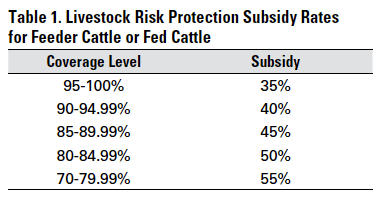Comprehending Animals Risk Security (LRP) Insurance: A Comprehensive Overview
Navigating the realm of livestock danger security (LRP) insurance policy can be an intricate undertaking for numerous in the agricultural sector. This kind of insurance coverage supplies a security internet versus market changes and unexpected circumstances that could influence livestock manufacturers. By comprehending the details of LRP insurance coverage, manufacturers can make enlightened choices that may protect their procedures from financial risks. From just how LRP insurance functions to the various protection choices available, there is much to uncover in this extensive guide that could possibly shape the method livestock manufacturers come close to danger management in their companies.

How LRP Insurance Coverage Functions
Sometimes, recognizing the auto mechanics of Animals Risk Security (LRP) insurance coverage can be complicated, however damaging down just how it functions can supply clearness for farmers and ranchers. LRP insurance coverage is a danger administration device developed to protect livestock producers versus unexpected rate decreases. The policy allows producers to establish a protection degree based upon their details demands, picking the variety of head, weight range, and insurance coverage rate. As soon as the policy is in location, if market prices fall listed below the protection price, producers can sue for the difference. It is necessary to keep in mind that LRP insurance is not an earnings assurance; rather, it concentrates exclusively on rate danger protection. The coverage period normally varies from 13 to 52 weeks, supplying adaptability for manufacturers to select a period that aligns with their manufacturing cycle. By using LRP insurance coverage, herdsmans and farmers can mitigate the economic risks related to varying market value, making sure greater security in their operations.
Qualification and Protection Options
When it concerns insurance coverage choices, LRP insurance policy supplies manufacturers the flexibility to select the coverage level, coverage duration, and endorsements that finest match their threat management requirements. Insurance coverage degrees normally vary from 70% to 100% of the anticipated ending value of the insured livestock. Manufacturers can likewise choose protection durations that align with their manufacturing cycle, whether they are guaranteeing feeder livestock, fed cattle, swine, or lamb. Endorsements such as rate risk security can additionally customize protection to shield versus unfavorable market changes. By understanding the eligibility criteria and protection choices readily available, livestock producers can make enlightened choices to handle threat successfully.
Advantages And Disadvantages of LRP Insurance Coverage
When reviewing Animals Danger Protection (LRP) insurance coverage, it is essential for livestock manufacturers to evaluate the advantages and disadvantages inherent in this threat monitoring device.

One of the primary benefits of LRP insurance policy is its ability to give protection against a decline in livestock prices. In addition, LRP insurance coverage provides a degree of flexibility, permitting producers to customize coverage levels and plan durations to suit their certain demands.
Nonetheless, there are also some drawbacks to take into consideration. One constraint of LRP insurance coverage is that it does not protect against all kinds of threats, such as disease break outs or natural calamities. Moreover, costs can sometimes be expensive, specifically for producers with huge animals herds. It is essential for manufacturers to very carefully analyze their individual risk exposure and monetary scenario to establish if LRP insurance policy is the appropriate risk management tool for their operation.
Understanding LRP Insurance Policy Premiums

Tips for Maximizing LRP Advantages
Taking full advantage of the advantages of Animals Risk Defense (LRP) insurance policy needs tactical preparation and positive risk administration - Bagley Risk Management. To take advantage of your LRP coverage, consider the following pointers:
Frequently Assess Market Problems: Keep informed about market fads and price variations in the animals sector. By monitoring these aspects, you can make enlightened choices about when to purchase LRP coverage to protect versus prospective losses.
Establish Realistic Insurance Coverage Levels: When choosing protection levels, consider your production costs, market value of animals, and potential dangers - Bagley Risk Management. Setting sensible insurance coverage levels makes sure that you are appropriately protected without overpaying for unneeded insurance
Expand Your Insurance Coverage: Rather than depending exclusively on LRP insurance policy, think about diversifying your danger administration strategies. Integrating LRP with other danger administration tools such as futures contracts or choices can provide detailed insurance coverage versus market uncertainties.
Evaluation and Change Coverage Frequently: As market problems change, occasionally assess your LRP coverage to ensure it lines up with your existing danger exposure. Readjusting insurance coverage degrees and timing of purchases can assist enhance your threat protection strategy. By following these pointers, you can take full advantage of the advantages of LRP insurance policy and secure your animals procedure against unanticipated risks.
Conclusion
Finally, livestock risk security (LRP) insurance policy is an important device for farmers to take care of the monetary dangers linked with their animals operations. By comprehending exactly how LRP works, qualification and protection options, as well as the pros and disadvantages of this insurance policy, farmers can make enlightened choices to shield their resources. By very carefully taking into consideration LRP premiums and carrying out approaches to make best use of advantages, farmers can alleviate possible losses and guarantee the sustainability of their operations.
Animals producers interested in getting Livestock Threat Protection (LRP) insurance can discover a range of eligibility standards and protection choices read more customized to their details animals procedures.When it comes to insurance coverage choices, LRP insurance uses producers the versatility to select the protection level, coverage period, and endorsements that ideal match their threat monitoring requirements.To grasp the details of Animals Danger Protection (LRP) insurance policy totally, understanding the variables affecting LRP insurance policy premiums is critical. LRP insurance coverage premiums are index determined by various aspects, consisting of the coverage level picked, the expected price of livestock at the end of the protection duration, the kind of animals being insured, and the length of the protection period.Review and Readjust Coverage Frequently: As market problems transform, regularly review your LRP coverage to guarantee it straightens with your existing danger direct exposure.